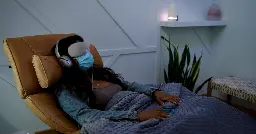Inside psychedelic-assisted therapy: How exactly does it work?
Inside psychedelic-assisted therapy: How exactly does it work?
After veterans went through FDA-approved trials with other psychedelic drugs, two-thirds no longer had PTSD. Several of these trials are happening in the U.S. now.

Inside a spa-like room at the Institute for Integrative Therapies (ITT) in Eden Prairie are four recliners, several sets of headphones and eye coverings.
They are there for when patients embark on what ITT's founder, Dr. Manoj Doss, calls their psychedelic journey. The chairs are reclined, the eye coverings go on, the music is piped in and the psychedelic is then given, via lozenge or injection.
"The reason is we want to make this completely introspective," said Dr. Doss. "There's no external stimuli that is affecting their journey and they completely inwards towards it."
A facilitator therapist sits in the room with the patients to guide them through rough spots or help them with anything they want to bring up. Dr. Doss is always nearby, just in case there are side effects, like nausea, headaches or dizziness.
But, this journey begins long before any patient ever receives a psychedelic drug. At this clinic – the first of its kind in Minnesota – that drug is ketamine, the only legal psychedelic in the state. Ketamine was created as an anesthetic in the 1970s, but at lower doses, it can produce psychedelic states.
Before being administered the ketamine, patients first required to go through a medical assessment that includes looking at any cardiovascular problems or history of mania or psychosis. Those histories might make them ineligible for this kind of therapy. After that, patients must undergo three to five psychotherapy sessions to prepare to talk about what issues they want to address and what they hope the gain from the experience. Following the medication, patients continue with their therapy with a hope to find a breakthrough, changes in behavior, or shifts in perceptions.
"The psychedelic is not the cure itself," said Dr. Doss. "The psychedelic is the catalyst or the mediator."
In an interview with CBS News, former Marine Scott Ostrom told CBS' David Martin that using psychedelics in therapy allowed him to open up and peel away the layers of trauma. He credits the psychedelic treatment and therapy with getting rid of panic attacks and thoughts of suicide. Ostrom had been part of a large trial involving the psychedelic drug MDMA.
These trials, conducted by the Multidisciplinary Association for Psychedelic Studies, found two-thirds of people using this treatment no longer reported symptoms of PTSD. They are in the final stage of research required by the Food and Drug Administration and just one of several FDA-approved trials involving the use of therapeutic use of psychedelics.
"After those three MDMA sessions," Ostrom said, "I haven't had a nightmare about the war since."
Dr. Voss said there are several thoughts and theories about how psychedelics affect the human brain, but the prevailing one has to do with the brain creating new circuits and connections. Essentially, they can help un-stick "stuck" thoughts, like ruminations, self-doubt, obsessions or compulsions. That then gives the psychotherapy, he said, a better chance of being successful.
"What psychedelics can do is basically shake up a snow globe and give you a fresh set of powder to ski on," Dr. Doss.
Most psychedelics have been illegal in the U.S. since the 1970s, but there are several drugs, including MDMA and psylocibin, that are expected to apply for approval to the FDA.
"In the right setting with the right provider, it's an extraordinarily important tool," said Dr. Doss. "It's not just for the mentally ill, it's for everyone in between that just wants a better life."